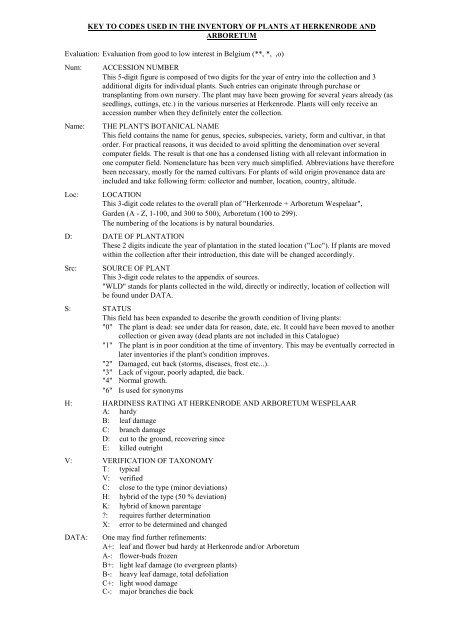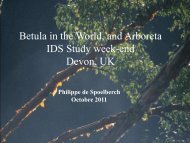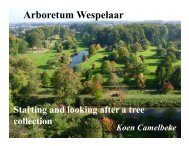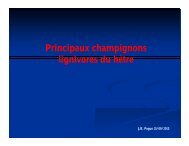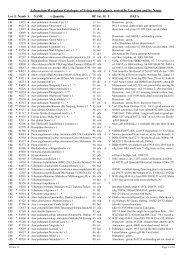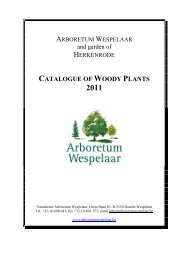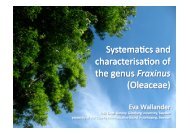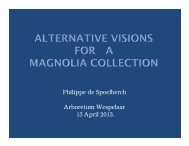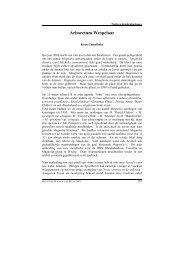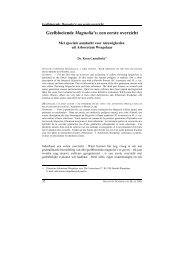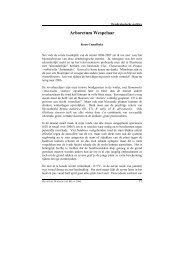catalogue of woody plants 2011 - Arboretum Wespelaar
catalogue of woody plants 2011 - Arboretum Wespelaar
catalogue of woody plants 2011 - Arboretum Wespelaar
You also want an ePaper? Increase the reach of your titles
YUMPU automatically turns print PDFs into web optimized ePapers that Google loves.
KEY TO CODES USED IN THE INVENTORY OF PLANTS AT HERKENRODE AND<br />
ARBORETUM<br />
Evaluation: Evaluation from good to low interest in Belgium (**, *, ,o)<br />
Num: ACCESSION NUMBER<br />
This 5-digit figure is composed <strong>of</strong> two digits for the year <strong>of</strong> entry into the collection and 3<br />
additional digits for individual <strong>plants</strong>. Such entries can originate through purchase or<br />
transplanting from own nursery. The plant may have been growing for several years already (as<br />
seedlings, cuttings, etc.) in the various nurseries at Herkenrode. Plants will only receive an<br />
accession number when they definitely enter the collection.<br />
Name: THE PLANT'S BOTANICAL NAME<br />
This field contains the name for genus, species, subspecies, variety, form and cultivar, in that<br />
order. For practical reasons, it was decided to avoid splitting the denomination over several<br />
computer fields. The result is that one has a condensed listing with all relevant information in<br />
one computer field. Nomenclature has been very much simplified. Abbreviations have therefore<br />
been necessary, mostly for the named cultivars. For <strong>plants</strong> <strong>of</strong> wild origin provenance data are<br />
included and take following form: collector and number, location, country, altitude.<br />
Loc: LOCATION<br />
This 3-digit code relates to the overall plan <strong>of</strong> "Herkenrode + <strong>Arboretum</strong> <strong>Wespelaar</strong>",<br />
Garden (A - Z, 1-100, and 300 to 500), <strong>Arboretum</strong> (100 to 299).<br />
The numbering <strong>of</strong> the locations is by natural boundaries.<br />
D: DATE OF PLANTATION<br />
These 2 digits indicate the year <strong>of</strong> plantation in the stated location ("Loc"). If <strong>plants</strong> are moved<br />
within the collection after their introduction, this date will be changed accordingly.<br />
Src: SOURCE OF PLANT<br />
This 3-digit code relates to the appendix <strong>of</strong> sources.<br />
"WLD" stands for <strong>plants</strong> collected in the wild, directly or indirectly, location <strong>of</strong> collection will<br />
be found under DATA.<br />
S: STATUS<br />
This field has been expanded to describe the growth condition <strong>of</strong> living <strong>plants</strong>:<br />
"0" The plant is dead: see under data for reason, date, etc. It could have been moved to another<br />
collection or given away (dead <strong>plants</strong> are not included in this Catalogue)<br />
"1" The plant is in poor condition at the time <strong>of</strong> inventory. This may be eventually corrected in<br />
later inventories if the plant's condition improves.<br />
"2" Damaged, cut back (storms, diseases, frost etc...).<br />
"3" Lack <strong>of</strong> vigour, poorly adapted, die back.<br />
"4" Normal growth.<br />
"6" Is used for synonyms<br />
H: HARDINESS RATING AT HERKENRODE AND ARBORETUM WESPELAAR<br />
A: hardy<br />
B: leaf damage<br />
C: branch damage<br />
D: cut to the ground, recovering since<br />
E: killed outright<br />
V: VERIFICATION OF TAXONOMY<br />
T: typical<br />
V: verified<br />
C: close to the type (minor deviations)<br />
H: hybrid <strong>of</strong> the type (50 % deviation)<br />
K: hybrid <strong>of</strong> known parentage<br />
?: requires further determination<br />
X: error to be determined and changed<br />
DATA: One may find further refinements:<br />
A+: leaf and flower bud hardy at Herkenrode and/or <strong>Arboretum</strong><br />
A-: flower-buds frozen<br />
B+: light leaf damage (to evergreen <strong>plants</strong>)<br />
B-: heavy leaf damage, total defoliation<br />
C+: light wood damage<br />
C-: major branches die back


